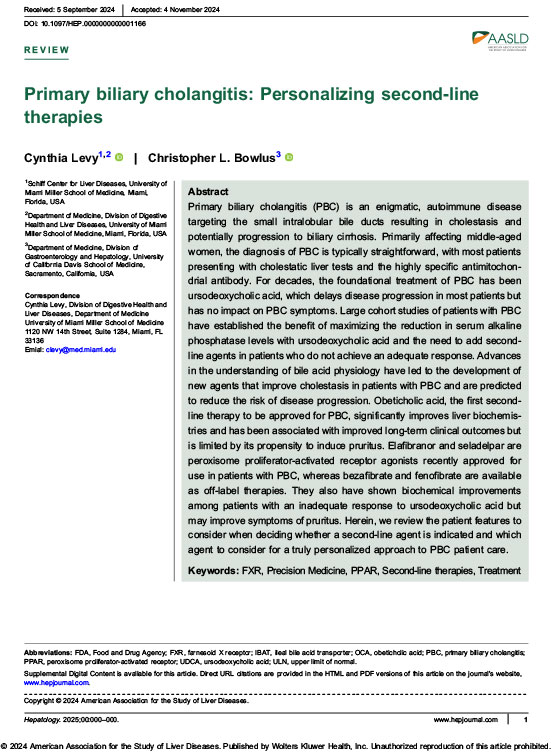Primary biliary cholangitis: Personalizing second-line therapies
September 2024
Abstract
Primary biliary cholangitis (PBC) is an enigmatic, autoimmune disease targeting the small intralobular bile ducts resulting in cholestasis and potentially progression to biliary cirrhosis. Primarily affecting middle-aged women, the diagnosis of PBC is typically straightforward, with most patients presenting with cholestatic liver tests and the highly specific antimitochondrial antibody. For decades, the foundational treatment of PBC has beenursodeoxycholic acid, which delays disease progression in most patients but has no impact on PBC symptoms. Large cohort studies of patients with PBC have established the benefit of maximizing the reduction in serum alkaline phosphatase levels with ursodeoxycholic acid and the need to add secondline agents in patients who do not achieve an adequate response. Advancesin the understanding of bile acid physiology have led to the development of new agents that improve cholestasis in patients with PBC and are predicted to reduce the risk of disease progression. Obeticholic acid, the first secondline therapy to be approved for PBC, significantly improves liver biochemistries and has been associated with improved long-term clinical outcomes but is limited by its propensity to induce pruritus. Elafibranor and seladelpar are peroxisome proliferator-activated receptor agonists recently approved for use in patients with PBC, whereas bezafibrate and fenofibrate are available as off-label therapies. They also have shown biochemical improvements among patients with an inadequate response to ursodeoxycholic acid but may improve symptoms of pruritus. Herein, we review the patient features to consider when deciding whether a second-line agent is indicated and which agent to consider for a truly personalized approach to PBC patient care.
Hepatology - © 2024 American Association for the Study of Liver Diseases. Published by Wolters Kluwer Health, Inc.
Note: Obeticholic acid, marketed under the brand name Ocaliva® for the treatment of primary biliary cholangitis (PBC), was voluntarily withdrawn from the US market by Intercept Pharmaceuticals following a request from the US Food and Drug Administration (FDA) on 11/14/2025

